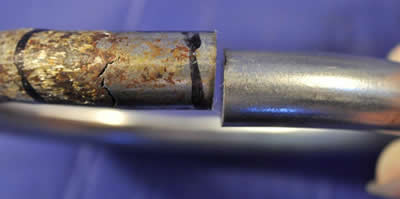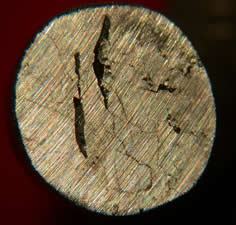Climbing Anchor issues in Railay and Tonsai Beach Thailand
Background
Since the start of the Thaitanium Project a dialogue regarding the use of stainless steel anchor rings has been debated. At the time there was no reported cases of stress corrosion cracking (the same type of corrosion found in the climbing bolts) in any of the anchor rings. The popular thought was that the steel rings was not seeing the same levels of corrosive elements as the bolts. There was an effort to reach out to metallurgist and another professionals about the use of these rings and there was very little they could answer for us with out years of research. By 2010 most, if not all of the climbs in Railay Bay already had anchors with the stainless steels rings. The decision was made to continue the use of the anchor ring set up and to keep an eye on it.

The Problem
During the re-bolting of the Cat Wall in early 2013 the Thaitanium Project found server cracking in one of the routes anchor rings. Not knowing exactly what to think and not wanting to jump to any conclusions, a few photos of the cracked ring were sent to the Thaitanium Project's metallurgy team. It was unclear of the history of where the ring came from and if it was even stainless steel. Also because of the cracks close proximity to the weld, we were unsure if the cracking was from a defect in the welding. It was decided that the rings would be taken to the United States for analysis and tested at a metallography facility. There was several tests done to see if it was in fact stress corrosion cracking, what type of steel it was and if the cracking was caused by improper welding.
Unfortunately, the tests did confirmed that the anchor ring was made out of stainless steel, the corrosion had nothing to do with the welding and it was SCC. It was everything we didn't want to hear. In fact, in the final report the lab tech said that it was the most cracking in stainless steel she had ever seen! Because the ring was SS and it had nothing to do with the welding meant that the unique combination of elements that cause the devastating corrosion in the bolts is now corroding the anchor rings. Which in turn means that every single ring will need to be changed.


The Solution
So where do we go from here? Well because of the hard work of the few dedicated folks at the Thaitanium Project we have the resources and the infrastructure to deal with this problem. We have already started the manufacturing of grade 2 Titanium anchor rings and they should be ready by the 2014 season. We will use the same fund raising techniques to pay for the rings as we are doing with the bolts. So if you purchase the DVD, T-shirt or any other swag it will go to help fund the removal and replacement of all stainless steel rings with the new Titanium rings.
What can you do
There are a couple things you can do as well. If you are climbing in Railay Bay or anything other area in Southern Thailand and are using any anchor rings please take the time to visually inspect the ring for any discolouration (rust) or cracking. If you see anything that looks suspicious, back the rings up with a carabiner and report it to the closest climbing school or on the Titanium Project's website. Unfortunately with SCC you can't always see the cracking this is because the cracking is on the inside of the steel where you will not be able to see any rust. So if you feel it necessary, again back the anchor rings up with a carabiner.
Now I would like to remind everyone that we have found one ring with SCC this doesn't mean that every ring is going to fail but it would be wise to use caution when using any Stainless Steel Anchor rings.
Stay safe and clip the red glue!
Josh Lyons - Founder of the Thaitanium Project
To donate to the replacement of all these rings with Titanium, go to http://thaitaniumproject.com/

